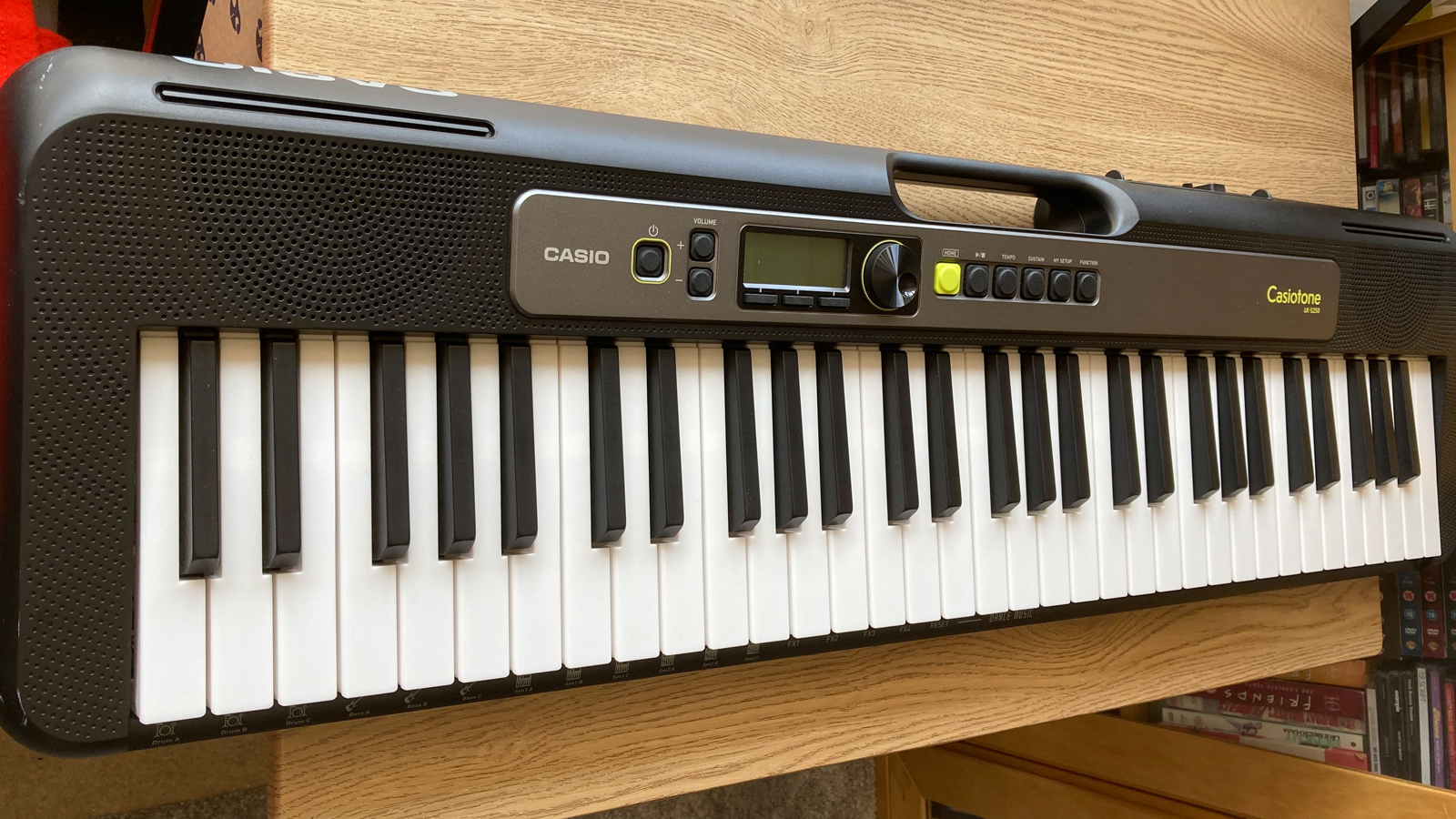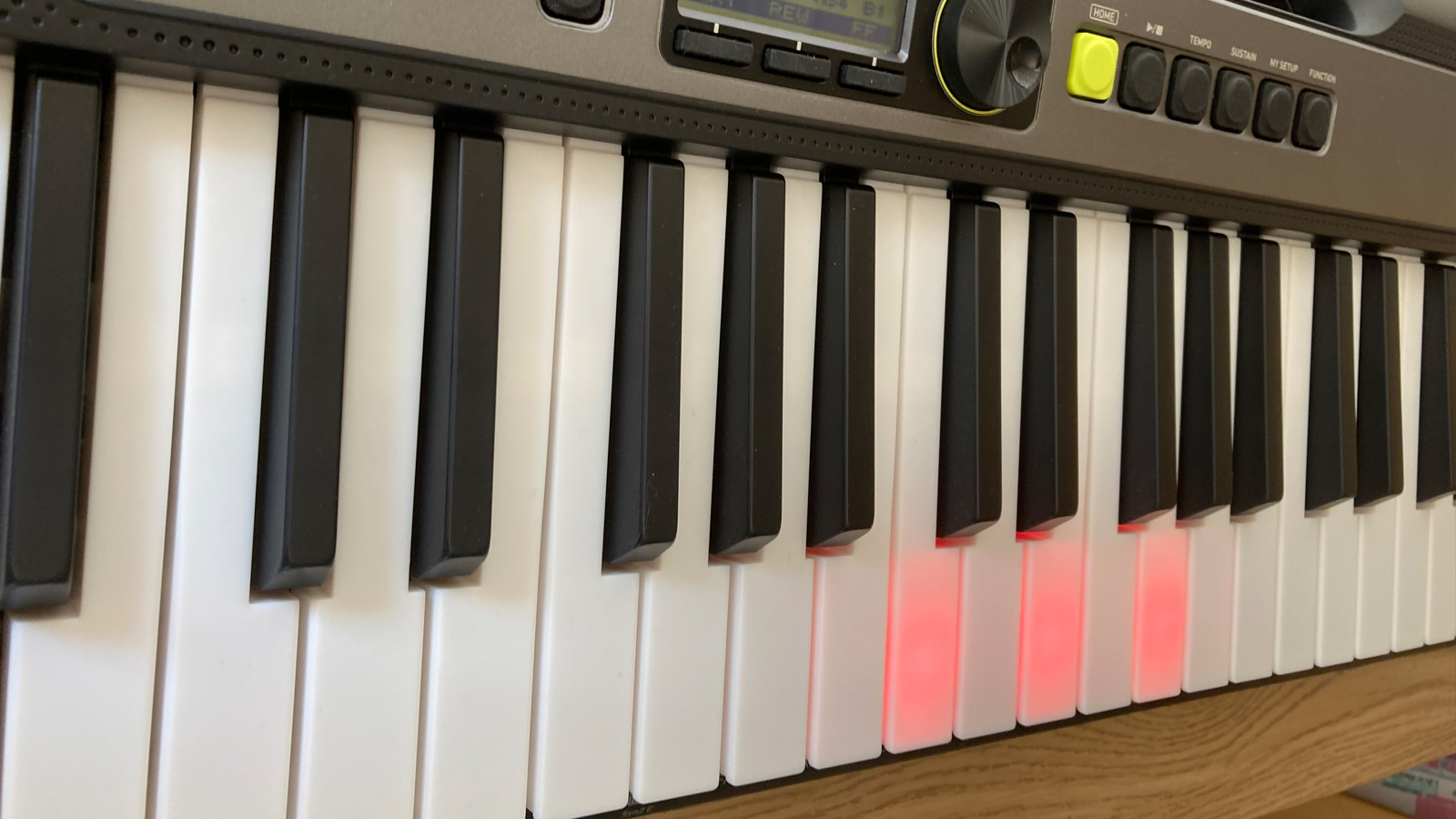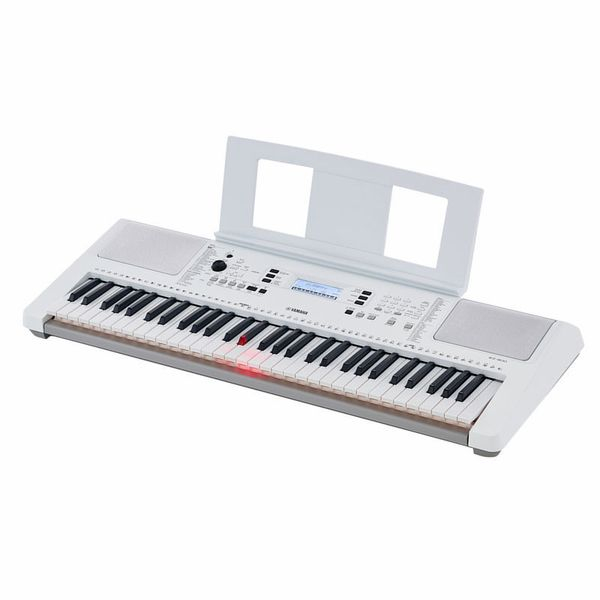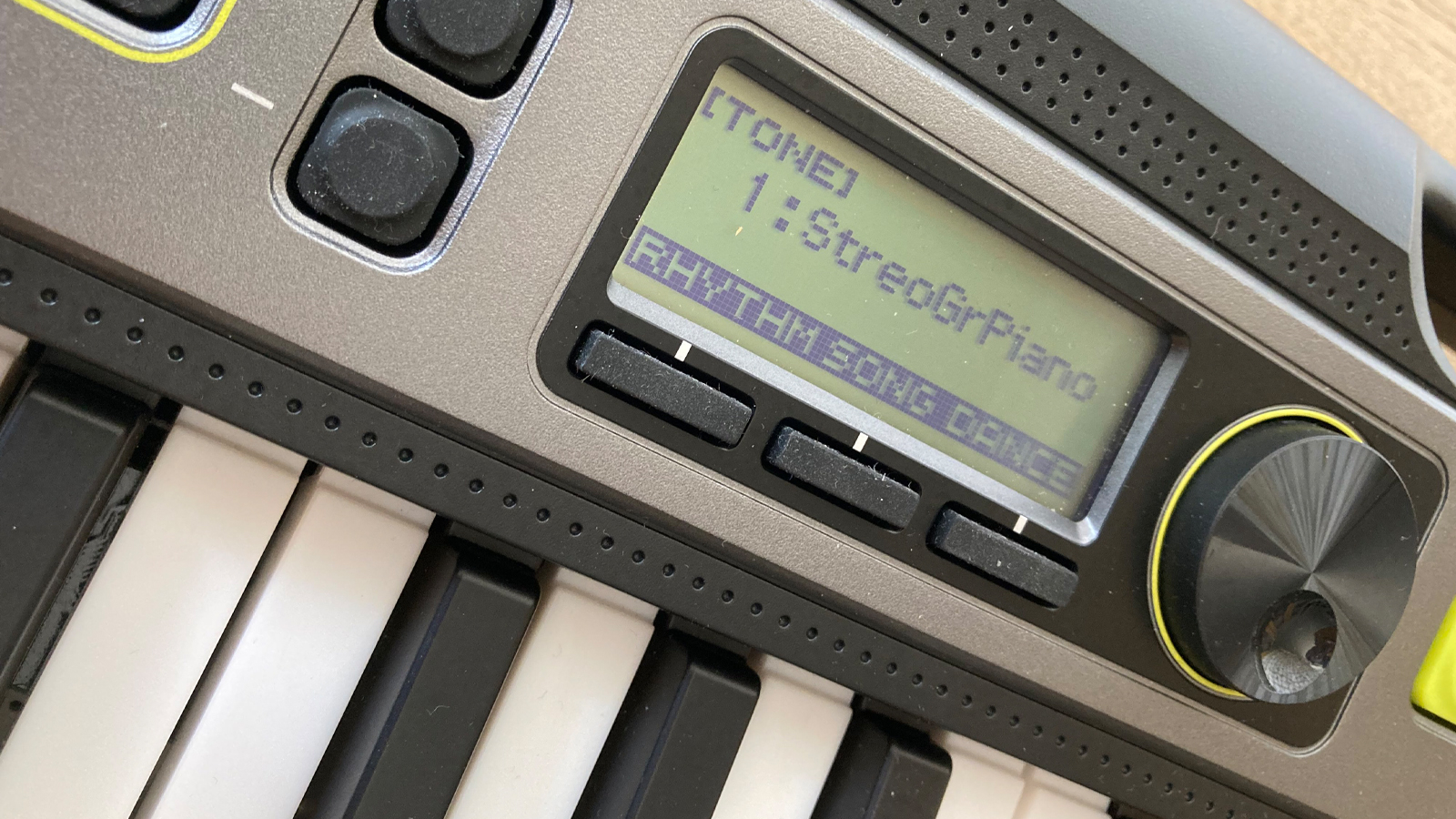MusicRadar Verdict
The LK-S250 belongs firmly in the home arranger/my-first-keyboard camp, so when making judgments about the sounds, we do have to remember that it’s primarily aimed at kids and beginners. For this demographic, it represents a decent starter keyboard, as it’s very easy to use and play, but if you’re anywhere beyond that level and looking for an illuminated keyboard with pro-level sounds, we’d recommend shelling out an extra £30 or so for the LK-S450, with its much better AiX sound engine and larger backlit display.
Pros
- +
Incredibly light and portable
- +
Key lighting system
- +
Velocity sensitive keys
- +
Simple to use
Cons
- -
Average sounds
- -
Display not backlit
- -
Needs a camera connection kit for iPad connection
MusicRadar's got your back
Casio Casiotone LK-S250 review: What is it?
Casio’s iconic Casiotone brand of portable electronic keyboards first brought affordable home keyboards to the market in the early 1980s but disappeared from the limelight at some point in the mid-1990s. In 2019, however, Casio took the welcome step of relaunching the brand with four new Casiotone models, the CT-S100, CT-S200, CT-S300, and LK-S250. Of these four, the LK-S250 was the top of the line until the introduction of the more pro-spec CT-S1, CT-S400 and LK-S450 Casiotone models in July 2021.
The LK-S250, then, is a lightweight, 61-key, portable electronic keyboard that can either be mains-powered or run off batteries. The ace up its sleeve is its illuminated keys feature, where each key contains a built-in red LED that guides you to play the correct notes when learning songs. Combine this with an onboard lesson feature, 60 built-in songs and compatibility with Casio’s free Casio Music Space mobile app (formerly known as Chordana Play) and you have what looks like an attractive package for those with children who want something small and light, with full-size keys, but which has a range of features designed to make learning easy and fun.
What we did find frustrating when we unboxed our LK-S250 review unit was the lack of any means of powering the instrument, with no mains power supply or batteries included. Our recommendation would be to check with your retailer that a PSU is included, as experiences seem to be varied in this regard according to the territory you’re purchasing in.
Casio Casiotone LK-S250 review: Performance & verdict

The first thing you notice about the LK-S250 is just how light and easy to carry around this thing is. The cleverly designed integrated carrying handle lends this keyboard a large degree of flingability, which if you’re under ten years old is a bonus, making it easy to carry and set up from room to room. The handle takes the form of a void in the upper region of the casing that has the added benefit of doubling up as a receptacle for the matching music rest to slot into. This is an essential add-on if you’re intending to use a tablet with your Casiotone, as it’s the perfect place to pop an iPad when running the Casio Music Space app.
With no onboard Bluetooth, however, connecting a device to run the Music Space app falls down to having the correct cable to hand, as again, none was included. The LK-S250 sports a micro USB B connector on the back, which in the case of an iPad needs to be hooked up to the lightning connector via a USB Camera Connection Kit in order to work.
Once up and running, we found the interface pretty easy to get to grips with, with an informative four-line LCD display navigated via three soft buttons and a jog wheel. Sadly the display isn’t backlit, making it difficult to read in low light. The twin 2.5W speaker system goes plenty loud enough for most home practising scenarios but was a bit lacking in low-end grunt.
Light duties


Yamaha EZ300:Yamaha’s take on the light-up keys idea, with over 600 sounds, 200 styles and 200 onboard songs to learn.
Casio LK-S450: The newer, upgraded version of the LK-S250 offers a high-quality AiX sound source, a better display and more sounds for not much more money.
Casio CT-S300: Near-identical spec to the LK-S250 but swaps the light-up keys for a pitch bend wheel
A big selling point for the LK-S250 is its educational appeal. As such, the keys are extremely easy to play, with a very light action and a noticeably shallow travel. They do feel very plasticky, no doubt due to the translucency required to allow them to light up, but this in no way affects playability. In use, the red key lights are supremely bright and look very impressive in darkened surroundings.
The LK-S250’s onboard lesson system is actually pretty useful for learning simple songs, with the usual smattering of 60 simple classical pieces and traditional folk tunes such as ‘Fur Elise’ and ‘Ave Maria’. The key light system has four modes, Easy, Listen, Watch and Remember. With Easy mode engaged, you can press any key to advance to the next note, correct or not. Listen plays the song and lights up the keys so you can listen to the piece and see it being performed with the lights showing you which notes to play. Watch is the mode where you have to play the correct key to advance to the next note, and Remember delays the lights, only prompting you with the correct note if you fail to play it after a few seconds. After progressing through the modes, your fingers start to take on muscle memory so that you can feel the tune and no longer need the lights to be a crutch. Once you get used to the system, it does work pretty well, but you can only have a maximum of four notes lit at any time and some of the timing aspects can be confusing, especially if you’re playing a baroque piece that features trills.
The Casio Music Space app adds a whole new dimension to the learning system, with a piano roll/Synthesia-style cascade method of learning songs that also illuminates the keys during lesson playback. Unfortunately, due to a lack of the required cable, we were unable to test this feature. We did enjoy the app’s Concert Play element though, which adds a beautifully-arranged orchestral backing to a score display of a library of famous classical pieces good enough to make the hairs on the back of your neck stand up.
Sound investment

The LK-S250 has a generous 400 tones on board, but sadly not many of them are particularly inspiring. The grand piano sound is just about passable, with the addition of an optional damper pedal. The electric pianos are okay, while the harpsichord is frankly dismal and many of the other tones are simply just average. The majority of them seemed to lack the professional polish of, say, the sounds found on the Yamaha E-series keyboards. Interestingly, its pricier cousin the LK-S450 boasts Casio’s AiX sound engine, which features a much more professional-sounding palette of voices. There’s no pitch bend or mod wheel on the S250, and no way to edit the sounds other than changing or removing the reverb effect.
The 77 rhythms are standard arranger keyboard fare, but each beat does at least get a couple of variations and fill-ins that can be triggered on the fly for a bit of added interest. Equally, the auto-accompaniment feature, where you trigger chords and bass parts by holding down chord shapes with your left hand is functional enough, but something weird was going on in some of the pre-programmed bass lines on some of the parts that we couldn’t quite figure out.
Elsewhere, the Dance music feature offers solid entertainment for kids for a while, allowing the triggering of a selection of around 50 sets of pre-rendered drum, bass and synth parts from the keys that can be mixed together with four types of effect on the fly. There are just about enough possible combinations of elements here to hold attention for an afternoon or so, but only if you’re still on the tooth fairy’s client list.
Casio Casiotone LK-S250 review: Hands-on demos
Alamo Music Centre
Jeremy See
Merriam Music
Casio Casiotone LK-S250 review: Specifications
- Dimensions (mm): 930 x 256 x 73
- Weight: 3.4㎏
- Keys: 61 full-size, illuminated, velocity-sensitive with three levels of touch response
- Polyphony: 48
- Number of Tones: 400
- Number of Rhythms / Styles: 77
- Number of Built-in Songs: 60
- Other features: Auto accompaniment, Dance Music mode, Step Up onboard lesson system, Casio Music Space compatibility
- Speakers: 2 x 2.5 W
- Power Supply: 12V DC / 6 x AA Batteries
- Connectivity: 3.5mm headphones jack, 6.3mm sustain pedal input, 6.3mm microphone input, 3.5mm audio input, Micro USB
- Contact: Casio
Dave has been making music with computers since 1988 and his engineering, programming and keyboard-playing has featured on recordings by artists including George Michael, Kylie and Gary Barlow. A music technology writer since 2007, he’s Computer Music’s long-serving songwriting and music theory columnist, iCreate magazine’s resident Logic Pro expert and a regular contributor to MusicRadar and Attack Magazine. He also lectures on synthesis at Leeds Conservatoire of Music and is the author of Avid Pro Tools Basics.
“A synthesizer that is both easy to use and fun to play whilst maintaining a decent degree of programming depth and flexibility”: PWM Mantis review
“I feel like that song had everything we needed to come back with”: Bring Me The Horizon’s Lee Malia on Shadow Moses, its riff and the secrets behind its tone, and why it was the right anthem at the right time
“I said, ‘Are we sure we can write a song about death?’”: The story of Mike + The Mechanics' classic No.1 The Living Years











